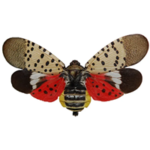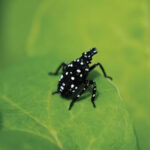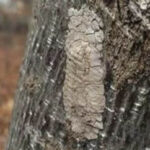 Some of you may have heard of the spotted lanternfly. Though named lanternfly, this insect is not a true “fly.” The spotted lanternfly was first detected in North America in Berks County in the fall of 2014. Since then, it has moved into 13 Pennsylvania counties and into Virginia. Those counties are under a quarantine that requires items moving out of the area to be thoroughly inspected.
Some of you may have heard of the spotted lanternfly. Though named lanternfly, this insect is not a true “fly.” The spotted lanternfly was first detected in North America in Berks County in the fall of 2014. Since then, it has moved into 13 Pennsylvania counties and into Virginia. Those counties are under a quarantine that requires items moving out of the area to be thoroughly inspected.
 Even though the spotted lanternfly has been in Pennsylvania for a number of years, there is still much to learn about its biology and host plants. The adults prefer feeding and laying eggs on tree of heaven, but also willow, maple, poplar, sycamore, and fruit trees. The nymphs (immatures) feed on many host plants including the ones above, but also oak, walnut, poplar, and grape.
Even though the spotted lanternfly has been in Pennsylvania for a number of years, there is still much to learn about its biology and host plants. The adults prefer feeding and laying eggs on tree of heaven, but also willow, maple, poplar, sycamore, and fruit trees. The nymphs (immatures) feed on many host plants including the ones above, but also oak, walnut, poplar, and grape.
 Their feeding takes nutrients from the plants, causes small wounds that may be points of entry for pathogens, and the lanternflies produce a lot of sticky waste called honeydew that drips from trees. One of the major concerns in Pennsylvania and other states is the spotted lanternfly likes to feed on grape vines and can cause significant plant injury and economic loss.
Their feeding takes nutrients from the plants, causes small wounds that may be points of entry for pathogens, and the lanternflies produce a lot of sticky waste called honeydew that drips from trees. One of the major concerns in Pennsylvania and other states is the spotted lanternfly likes to feed on grape vines and can cause significant plant injury and economic loss.
 The lanternfly overwinters in the egg stage. Females lay eggs on tree trunks and lots of other non-host surfaces – such as rocks, buildings, and patio furniture. The egg mass is covered with a gray, waxy coating and that makes it hard to see them on bark. Though the insect can fly as an adult, the accidental movement of egg masses may be the most serious way this insect spreads. The eggs hatch in the spring. Adults develop in late July and prefer to feed on tree of heaven. Lanternflies feed together as a group and are active on the trunk of plants in the evening.
The lanternfly overwinters in the egg stage. Females lay eggs on tree trunks and lots of other non-host surfaces – such as rocks, buildings, and patio furniture. The egg mass is covered with a gray, waxy coating and that makes it hard to see them on bark. Though the insect can fly as an adult, the accidental movement of egg masses may be the most serious way this insect spreads. The eggs hatch in the spring. Adults develop in late July and prefer to feed on tree of heaven. Lanternflies feed together as a group and are active on the trunk of plants in the evening.